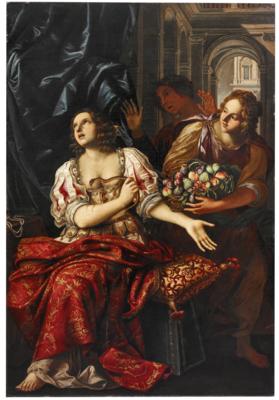Roman School, 17th Century

The Death of Cleopatra,
oil on canvas, 213.5 x 146 cm, framed
Provenance:
sale, Sotheby’s, London, 21 April 1993, lot 59 (as Neapolitan School, 17th Century, arched top);
Private European collection
The present painting shows close stylistic comparisons to the work of the Roman painter Angelo Caroselli (1585–1652). Caroselli’s oeuvre was strongly influenced by the naturalism of Caravaaggio, however, his innovative iconography and interest in the representation of texture, with decoratve elements is somewhat eclectic and entirely personal.
Caroselli often depicted female figures, as was observed by Giovanni Battista Passeri, one of the earliest of Caroselli’s biographers and it has been suggested this may have been due to Caroselli’s lifestyle. Indeed, the artist, after becoming a widower, resided with his painter-colleague Agostino Tassi, in a house also inhabited by courtesans (see G. B. Passeri, Vite de’ pittori, scultori ed architetti che anno lavorato in Roma: morti dal 1641 fino al 1673, Rome 1772, p. 193).
In the present composition Cleopatra is shown seated with her gaze turned upwards, her left arm outstretched, and her right hand holding the snake. Her costly embroidered dress of white silk, decorated with set gems, exposes her breast. Over her lap lies a cloth of heavy red brocade on which golden embroideries are modelled with small, quick brushstrokes. A stoic-looking servant appears next to her holding a basket richly filled with figs, peaches and plums. The figure in the background has her hands up in dismay.
A light source from the upper left illuminates the protagonist of the scene. The immaculate flesh tone and the luminous fabrics in gold and red contrast with the draped dark blue curtain and the less illuminated figure in the background. There is great attention given to the depiction of the different materials, including the rich fabric of golden red pattern executed in alternations of fine, thin brushstrokes arranged horizontally. The same the method is used in depicting the basket with highlights modelling form through gradations of colour.
Esperto: Mark MacDonnell
 Mark MacDonnell
Mark MacDonnell
+43 1 515 60 403
old.masters@dorotheum.com
11.05.2022 - 16:00
- Prezzo realizzato: **
-
EUR 45.500,-
- Stima:
-
EUR 60.000,- a EUR 80.000,-
Roman School, 17th Century
The Death of Cleopatra,
oil on canvas, 213.5 x 146 cm, framed
Provenance:
sale, Sotheby’s, London, 21 April 1993, lot 59 (as Neapolitan School, 17th Century, arched top);
Private European collection
The present painting shows close stylistic comparisons to the work of the Roman painter Angelo Caroselli (1585–1652). Caroselli’s oeuvre was strongly influenced by the naturalism of Caravaaggio, however, his innovative iconography and interest in the representation of texture, with decoratve elements is somewhat eclectic and entirely personal.
Caroselli often depicted female figures, as was observed by Giovanni Battista Passeri, one of the earliest of Caroselli’s biographers and it has been suggested this may have been due to Caroselli’s lifestyle. Indeed, the artist, after becoming a widower, resided with his painter-colleague Agostino Tassi, in a house also inhabited by courtesans (see G. B. Passeri, Vite de’ pittori, scultori ed architetti che anno lavorato in Roma: morti dal 1641 fino al 1673, Rome 1772, p. 193).
In the present composition Cleopatra is shown seated with her gaze turned upwards, her left arm outstretched, and her right hand holding the snake. Her costly embroidered dress of white silk, decorated with set gems, exposes her breast. Over her lap lies a cloth of heavy red brocade on which golden embroideries are modelled with small, quick brushstrokes. A stoic-looking servant appears next to her holding a basket richly filled with figs, peaches and plums. The figure in the background has her hands up in dismay.
A light source from the upper left illuminates the protagonist of the scene. The immaculate flesh tone and the luminous fabrics in gold and red contrast with the draped dark blue curtain and the less illuminated figure in the background. There is great attention given to the depiction of the different materials, including the rich fabric of golden red pattern executed in alternations of fine, thin brushstrokes arranged horizontally. The same the method is used in depicting the basket with highlights modelling form through gradations of colour.
Esperto: Mark MacDonnell
 Mark MacDonnell
Mark MacDonnell
+43 1 515 60 403
old.masters@dorotheum.com
|
Hotline dell'acquirente
lun-ven: 10.00 - 17.00
old.masters@dorotheum.at +43 1 515 60 403 |
| Asta: | Dipinti antichi I |
| Tipo d'asta: | Asta in sala con Live Bidding |
| Data: | 11.05.2022 - 16:00 |
| Luogo dell'asta: | Wien | Palais Dorotheum |
| Esposizione: | 30.04. - 11.05.2022 |
** Prezzo d’acquisto comprensivo dei diritti d’asta acquirente e IVA
Non è più possibile effettuare un ordine di acquisto su Internet. L'asta è in preparazione o è già stata eseguita.
